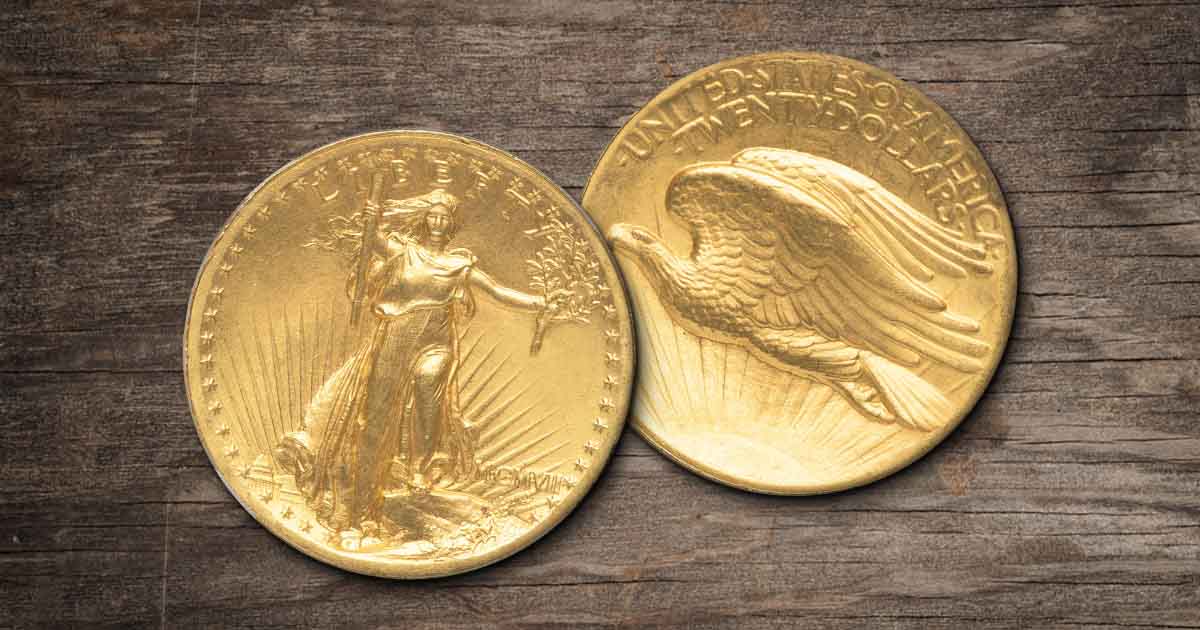
Augustus Saint-Gaudens was an Irish-American designer and sculptor best known for the $20 Saint-Gaudens Gold Double Eagle. As a sculptor, many consider Saint-Gaudens the master of the American art whose work epitomizes the ideals of the American Renaissance.
Background of Augustus Saint-Gaudens
Saint-Gaudens was born in Dublin, Ireland to French and Irish parents in 1848 and the family moved to New York City when he was six months old. His father was a shoemaker from the Saint-Gaudens area near the French Pyrenees.
At age 13, Saint-Gaudens began apprenticing with a cameo cutter in NYC. Cameo is a term used in numismatics but in sculpting, refers to bas-relief sculptures which are often carved in gemstones. Around the same time, he began taking art classes at night at the legendary Cooper Union in NYC.
When he was about 15 years old, Saint-Gaudens enrolled at the National Academy of Design and was hired as an apprentice to another cameo cutter, Jules Le Brethon. He completed his second apprenticeship at age 19 and traveled to Paris where he studied under François Jouffroy at the Parisian École des Beaux-Arts.
Saint-Gauden’s Career as a Sculptor and Engraver
When Saint-Gaudens was 21, he left France to study Roman art and architecture and began his first commissioned work. In 1876, when he was 28 years old, Augustus won a commission to produce a bronze memorial to honor David Farragut, a U.S. Navy Admiral of the Civil War. The Admiral Farragut Monument was unveiled on May 25, 1881, and Saint-Gauden’s first major work still stands in Manhattan’s Madison Square today.
Saint-Gaudens crafted a weathervane titled Diana of the Tower after the Roman goddess Diana for the second Madison Square Garden building tower between 1891 and 1893. The weathervane was created at the behest of Standford White, an architect who paid for the materials and convinced Saint-Gaudens to produce the work at no charge.
When Diana of the Tower was unveiled in 1891, it became the tallest point in Manhattan at a towering 317 feet above the ground. It was the first statue in that part of Manhattan illuminated at night by electric lighting and stood until the tower was demolished in 1925.
Saint-Gaudens went on to produce numerous statues commemorating Americans like Abraham Lincoln, William Tecumseh Sherman, and the Robert Gould Shaw Memorial in Boston Common, which took 14 years to complete.
American Coins Designed by August Saint-Gaudens
Around the turn of the 20th century, President Theodore Roosevelt chose Augustus Saint-Gaudens to redesign some of the United States coins with a greater sense of artistry. In response, Saint-Gaudens designed a $20 gold coin, a $10 gold coin, and a penny that was never minted.
The $20 Saint Gaudens Double Eagle
The $20 gold double eagle designed by Saint-Gaudens is considered one of the most beautiful coins issued by the U.S. Mint.
Saint-Gaudens produced an ultra-high relief $20 gold coin that required 11 strikes to mint, but the coins did not stack properly and only 20 were issued. One of these 20 was sold in 2009 for nearly $3 million.
The ultra-high relief design was adapted to a high relief version which took three strikes to mint. While these were deemed unfit for commerce, more than 12,000 were produced. Today, these have greater demand than almost any other U.S. coin.
From 1907 through 1933, the U.S. Mint produced a flattened version of the $20 gold double eagle with a standard relief. In 2009, there were 115,178 $20 gold double eagles issued in .9999 fine gold.
The $10 Indian Head Gold Eagle
Saint-Gaudens also produced the $10 Indian head gold eagle, a coin that had an intended impact on the face of U.S. coinage.
While his design has stood the test of time and the $10 Indian head gold eagle is valuable today, Saint-Gaudens omitted IN GOD WE TRUST from his design, which sparked public outrage. In response, Congress mandated the inclusion of the words on U.S. coins.
Augustus Saint-Gaudens’ impact on U.S. coins and American iconography cannot be understated. Today, his works stand in Springfield, Chicago, Mexico City, London, and New York City. His art serves to honor the heroes of American history with the aesthetic traditions of Rome and Greece, and the coins he designed exemplify this connection.




